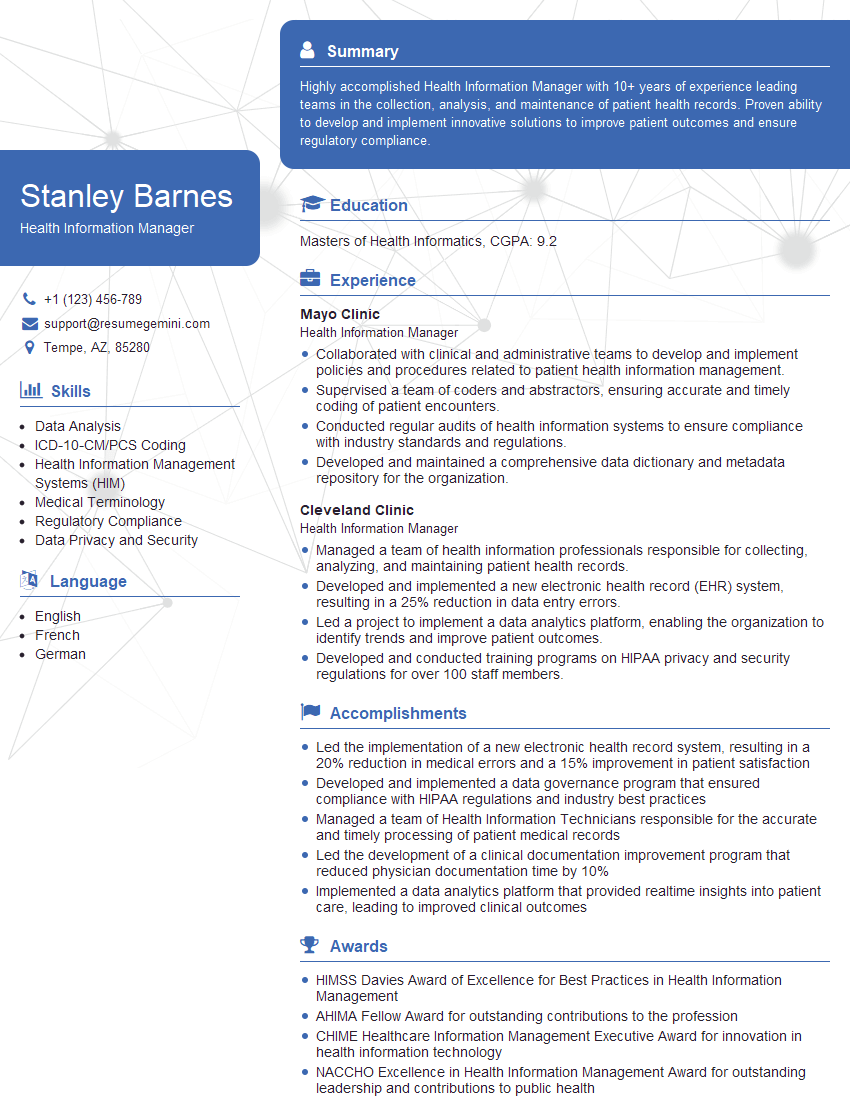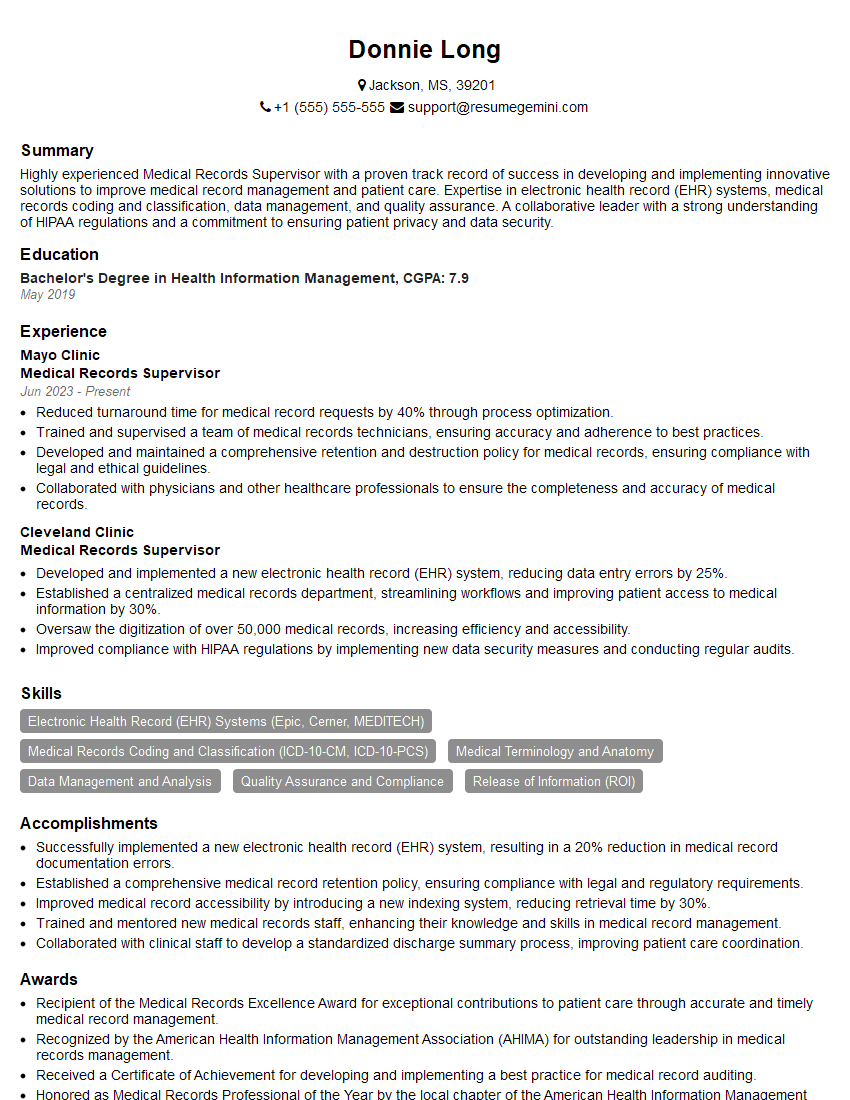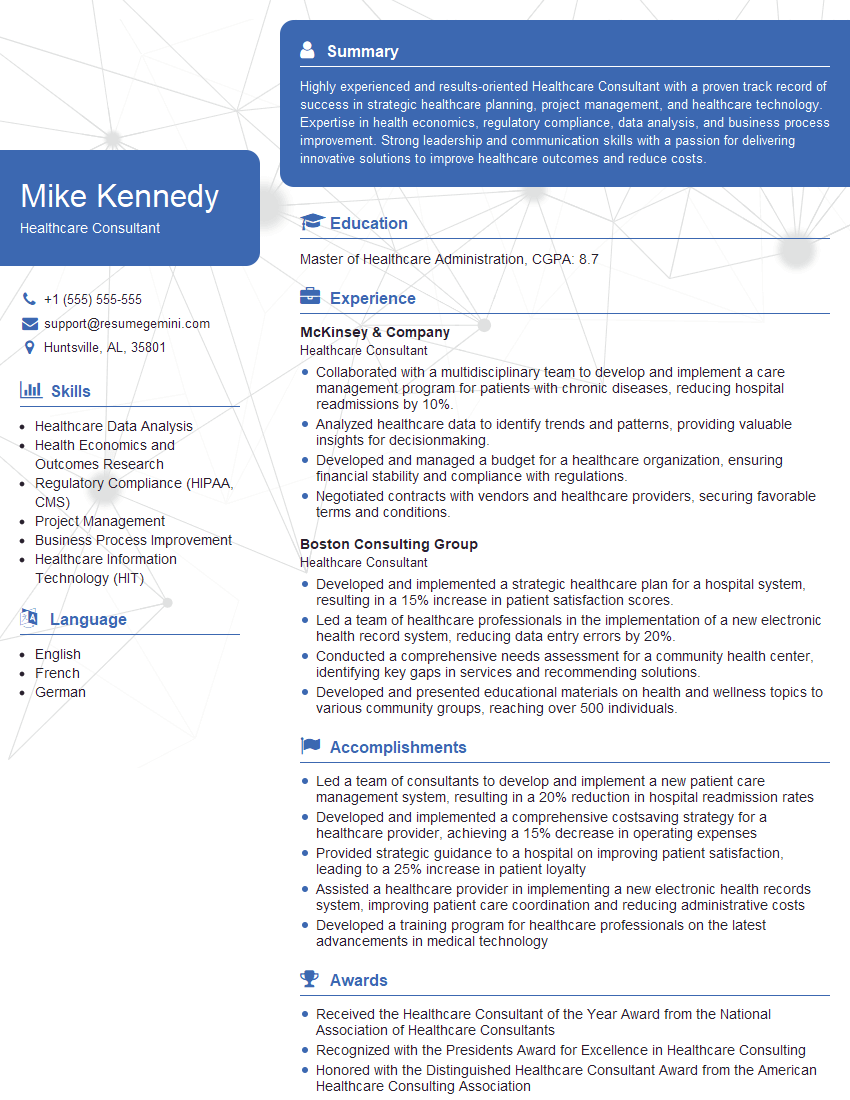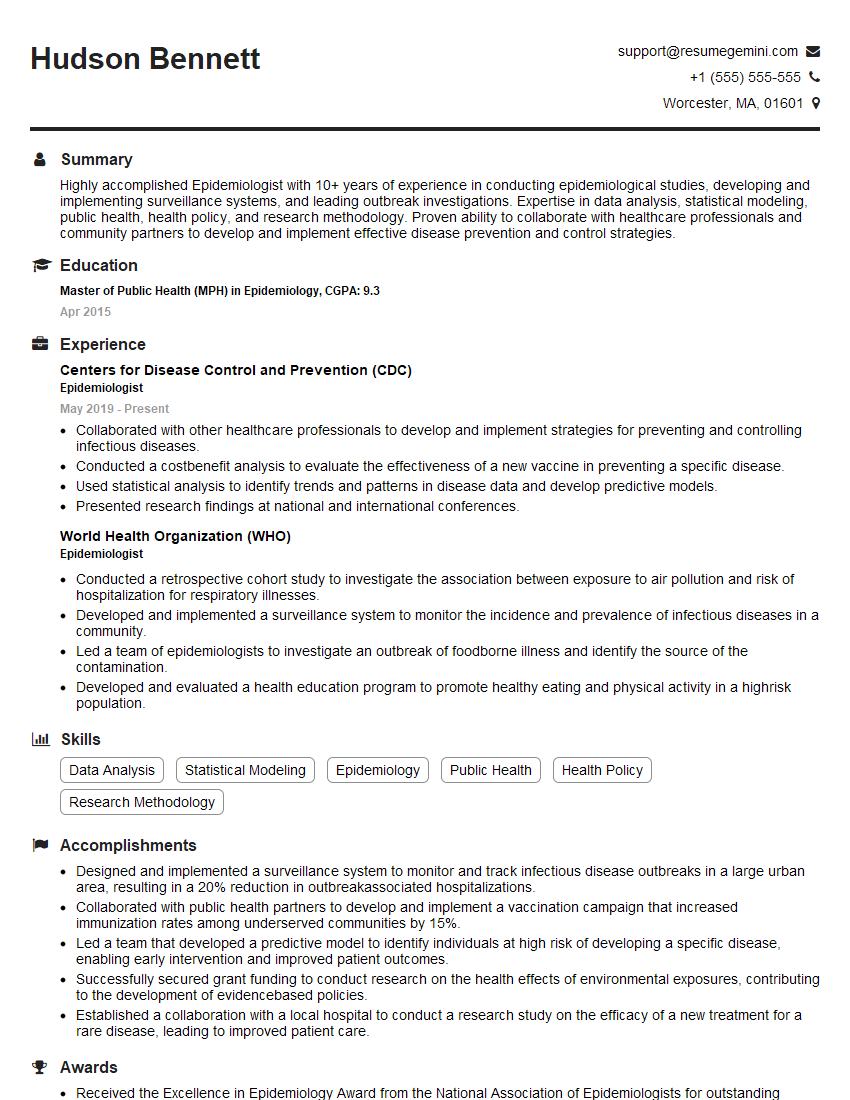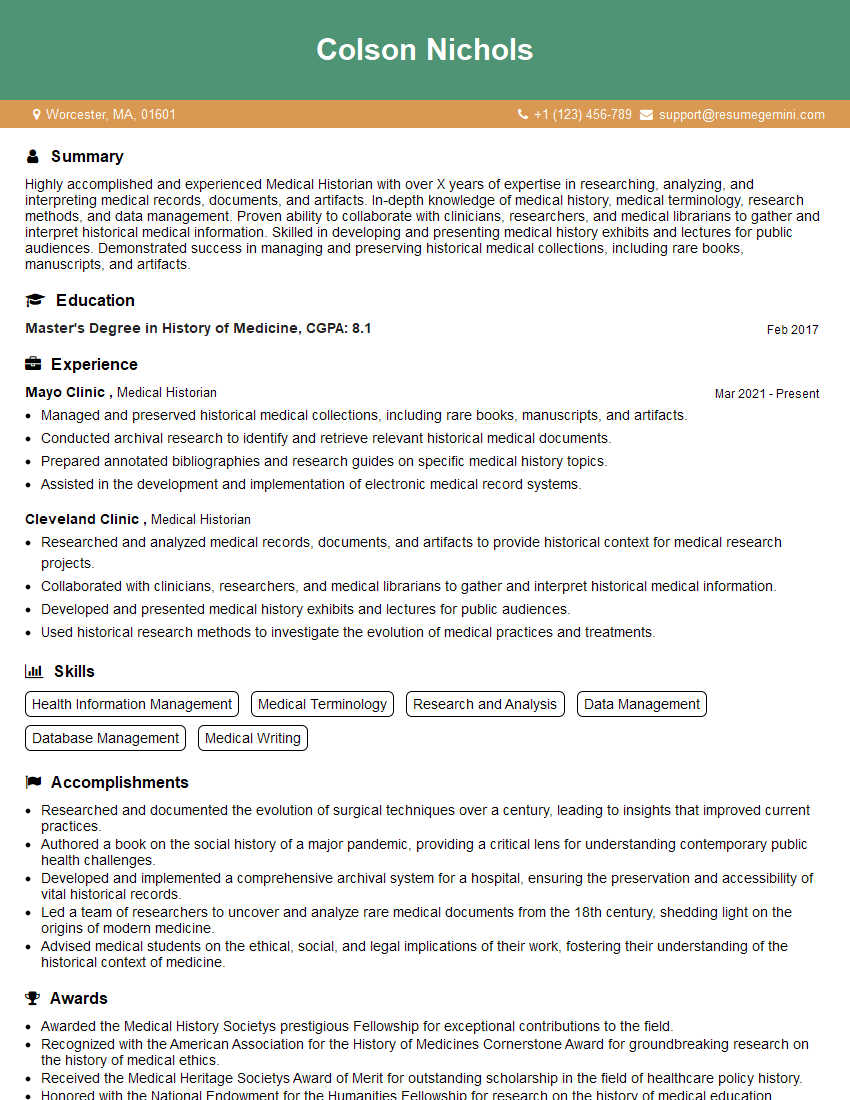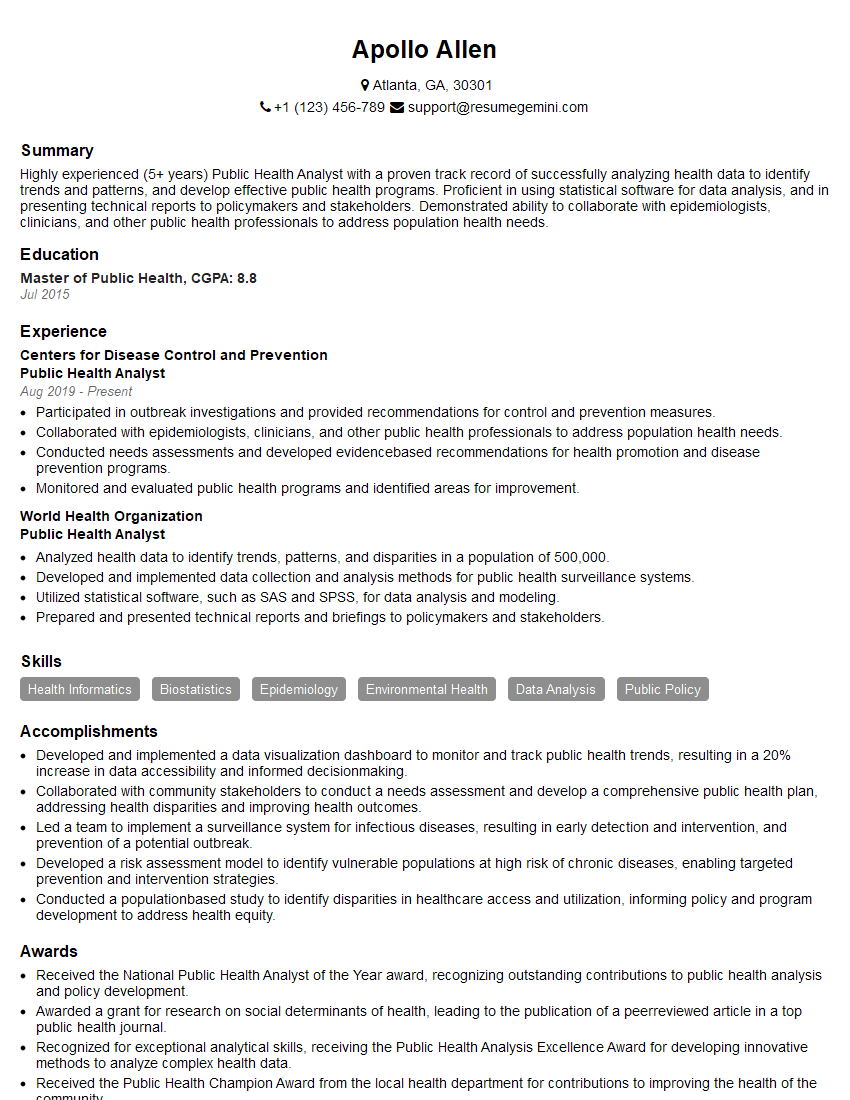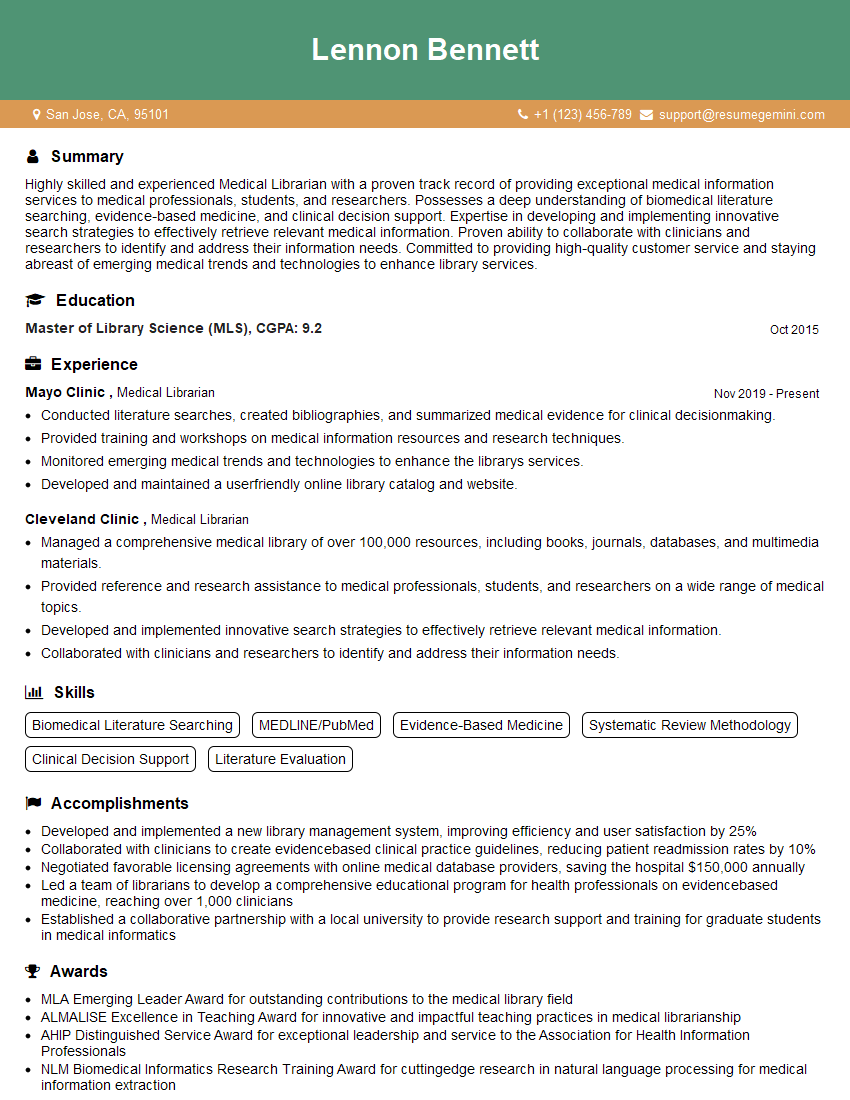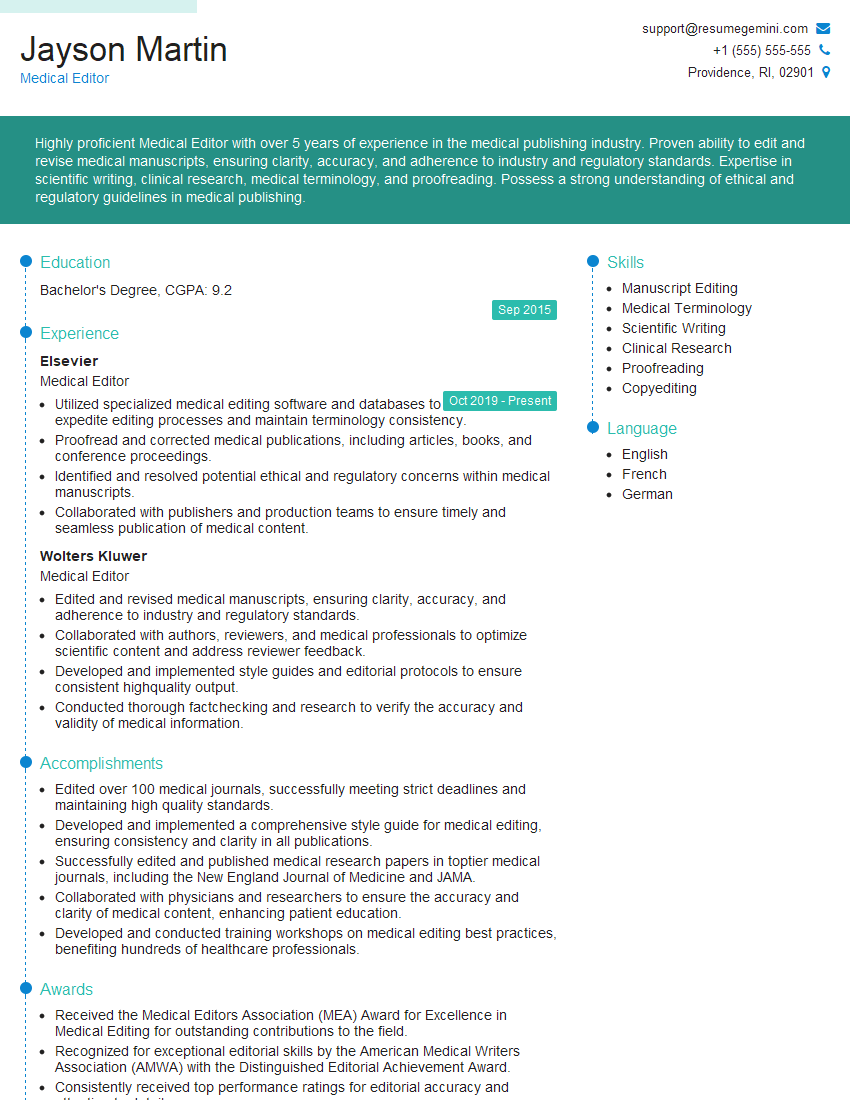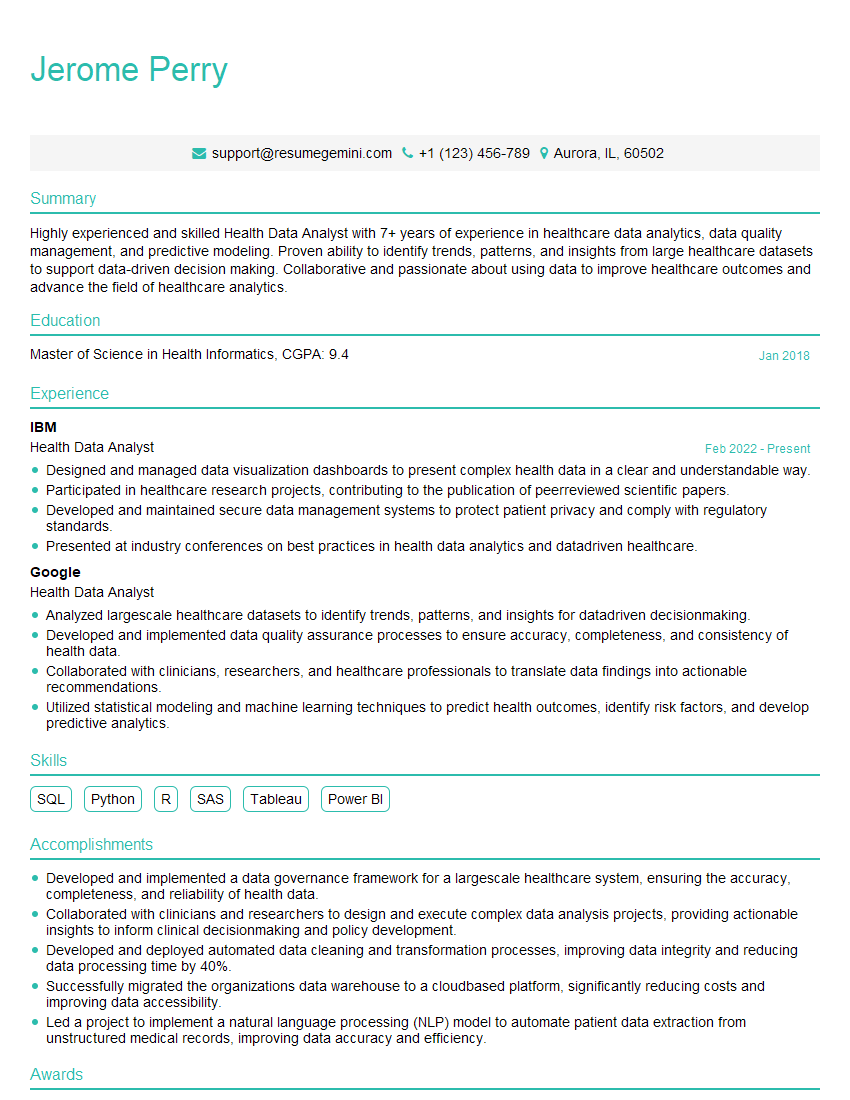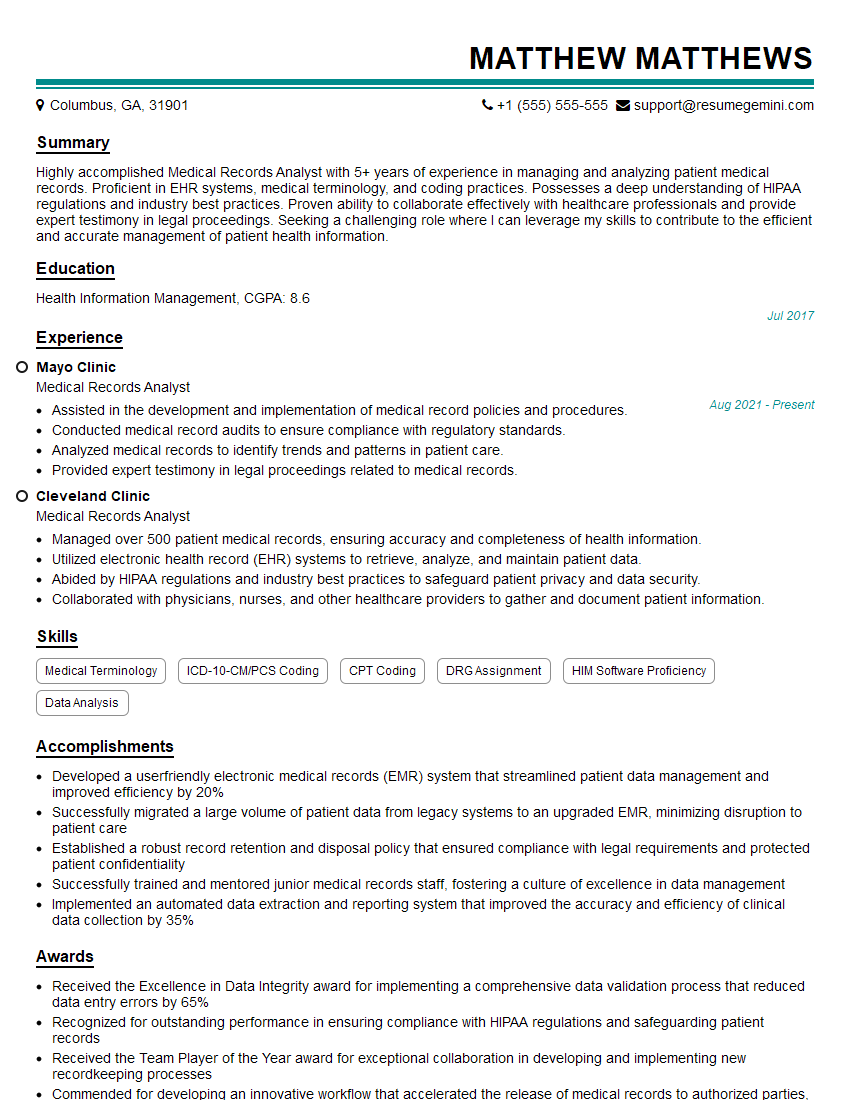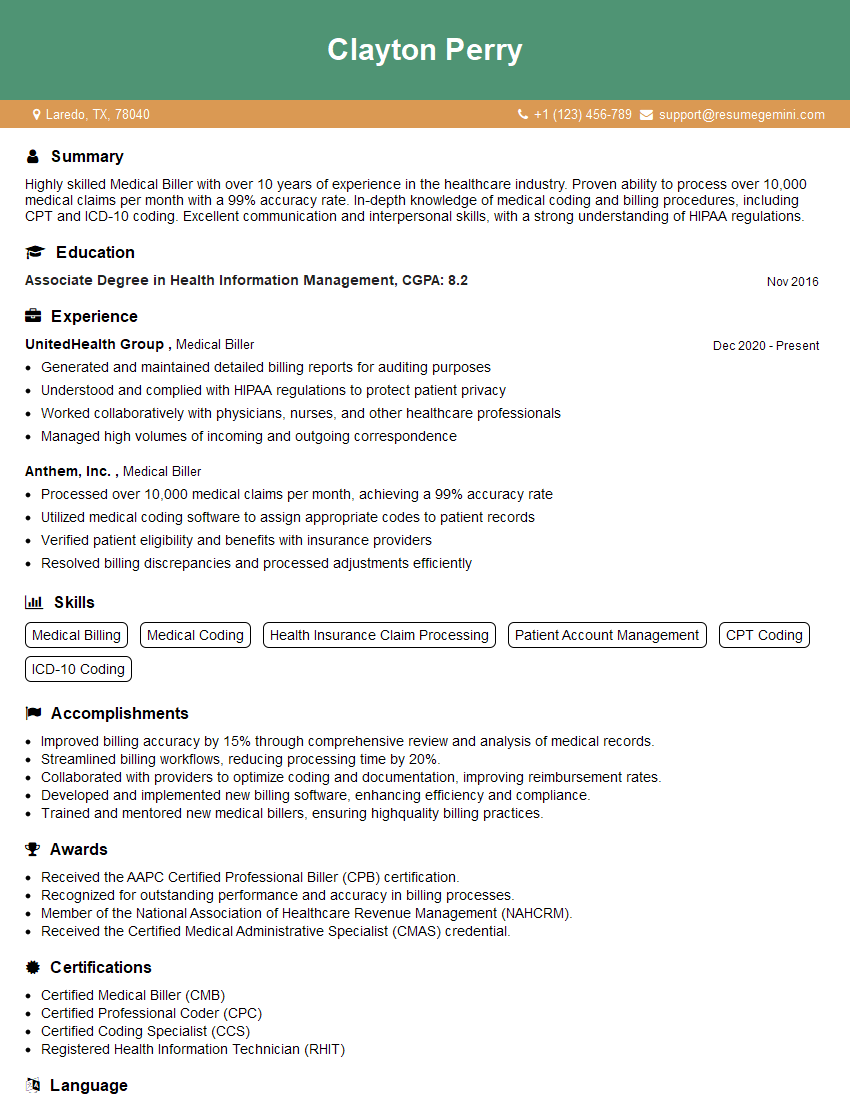Unlock your full potential by mastering the most common Medical History Analysis interview questions. This blog offers a deep dive into the critical topics, ensuring you’re not only prepared to answer but to excel. With these insights, you’ll approach your interview with clarity and confidence.
Questions Asked in Medical History Analysis Interview
Q 1. Explain the importance of accurate medical history documentation.
Accurate medical history documentation is the cornerstone of effective healthcare. It’s crucial for several reasons: it allows for proper diagnosis, guides treatment decisions, predicts potential risks, and ensures patient safety. Think of it as building a house – you need a strong foundation (accurate history) before you can build the walls (diagnosis and treatment).
Inaccurate or incomplete information can lead to misdiagnosis, inappropriate treatment, adverse drug reactions, and ultimately, poorer patient outcomes. For instance, a patient’s allergy to penicillin not documented correctly could have life-threatening consequences. Accurate documentation also facilitates communication between healthcare providers, ensuring continuity of care and preventing duplicated tests or procedures.
Q 2. Describe the different types of medical history information.
Medical history information encompasses a broad spectrum of data crucial for understanding a patient’s health. It can be categorized into several types:
- Personal History: Demographics (age, gender, ethnicity), occupation, lifestyle factors (smoking, alcohol consumption, exercise), family history of diseases.
- Past Medical History: Previous illnesses, surgeries, hospitalizations, injuries, allergies, immunizations. This section provides a timeline of the patient’s health journey.
- Family History: Genetic predispositions to diseases are often revealed through this, highlighting potential risks for the patient. For example, a family history of heart disease increases the patient’s risk.
- Social History: This delves into the patient’s social environment, including their relationships, living situation, occupation, and socioeconomic status. These factors can significantly impact their health.
- Medication History: A detailed list of current and past medications, including dosages, frequency, and reason for use. Interactions between drugs can be critically important.
- Review of Systems (ROS): A systematic inquiry covering all major body systems to identify any symptoms the patient may be experiencing.
Q 3. How do you identify inconsistencies or missing information in a patient’s medical history?
Identifying inconsistencies or missing information requires a meticulous approach. I typically use a combination of techniques:
- Cross-referencing: Comparing information from various sources like different medical records, lab reports, imaging studies, and even conversations with the patient.
- Timeline Analysis: Reviewing the chronological order of events to detect any discrepancies or gaps in the narrative. A sudden change in symptoms without a clear explanation may be a red flag.
- Pattern Recognition: Recognizing inconsistencies in reported symptoms or diagnoses, such as a patient claiming to be allergy-free but having a documented allergic reaction in the past.
- Data Validation: Checking data against known medical facts and established diagnostic criteria. For instance, if a patient reports a specific symptom, its correlation with potential diseases needs to be considered.
- Critical Thinking: Considering the overall context and clinical picture. Sometimes, seemingly contradictory information makes sense when viewed in a holistic manner.
For example, a discrepancy might emerge if a patient reports a certain surgery date, but hospital records reflect a different date. This requires further investigation to rectify the error.
Q 4. What methods do you use to verify the accuracy of medical history data?
Verifying the accuracy of medical history data is a critical step. I employ various methods:
- Patient Interview: Directly engaging with the patient to clarify inconsistencies or gather missing information, often the most reliable primary source.
- Contacting Previous Providers: Obtaining information from previous physicians or healthcare facilities to corroborate existing data or fill in gaps.
- Reviewing Lab and Imaging Reports: These objective findings can support or contradict the patient’s reported history.
- Consulting Medical Databases and Literature: Utilizing reputable medical databases to confirm the validity of diagnoses, treatment plans, and drug information.
- Utilizing Family Members or Caregivers: (With patient consent) Obtaining additional information from family members or caregivers who may have relevant insights into the patient’s health history.
For instance, if a patient reports a specific medication, I would verify the dosage and frequency by checking their prescription records.
Q 5. How do you handle incomplete or ambiguous medical history records?
Incomplete or ambiguous records require careful handling. My approach is to:
- Document the Gaps: Clearly note any missing or unclear information in the medical record, explicitly stating what is unknown.
- Explore Available Resources: Attempt to obtain missing information using the verification methods mentioned earlier.
- Make Reasonable Assumptions (with Caution): If information cannot be obtained, I would document any reasonable assumptions, carefully highlighting the uncertainty and limitations associated with such inferences.
- Prioritize Patient Safety: In cases of uncertainty, I would err on the side of caution and order additional investigations or consult with specialists to ensure the patient’s safety.
For example, if a patient’s allergy status is unclear, I would proceed cautiously, avoiding the potential allergen until clarification is achieved. This approach prioritizes safety.
Q 6. Explain the process of abstracting relevant information from medical records.
Abstracting relevant information from medical records involves systematically extracting key data points. The process typically involves:
- Identifying the Objective: Clearly defining the specific information needed for the task at hand (e.g., identifying patients with a specific disease for research).
- Selecting Relevant Records: Identifying and locating the medical records pertinent to the research question.
- Structured Data Extraction: Using structured data extraction tools or techniques to identify and extract specific data points, such as diagnoses, medications, and procedures from the medical records.
- Manual Chart Review: When structured data extraction is not possible or insufficient, manually reviewing the charts and extracting the relevant information. This can be time-consuming but essential for comprehensive data capture.
- Data Validation: Checking the extracted data for accuracy and consistency.
- Data Storage and Management: Storing and managing the extracted data in a secure and organized manner.
Think of it like searching for a specific ingredient (information) in a cookbook (medical record). You need a clear plan and methodical approach to efficiently find what you need. The process demands accuracy and attention to detail.
Q 7. Describe your experience with different electronic health record (EHR) systems.
Throughout my career, I’ve gained extensive experience with various EHR systems, including Epic, Cerner, and Meditech. Each system has its strengths and weaknesses concerning usability, data organization, and reporting capabilities.
My experience includes navigating complex data structures, mastering different search functionalities, and efficiently extracting information for clinical decision-making and research purposes. I’m proficient in using reporting tools within these systems to generate customized reports and analyze clinical data. For example, I’ve utilized Epic’s reporting tools to track patient outcomes for specific treatments. Understanding the nuances of different EHR systems is paramount for effective and efficient data retrieval and analysis.
Q 8. How do you ensure patient confidentiality when working with medical history data?
Patient confidentiality is paramount in medical history analysis. We adhere to strict protocols to protect sensitive health information. This involves several key strategies. Firstly, data is anonymized whenever possible, replacing identifying details like names and addresses with unique identifiers. Secondly, access to data is strictly controlled through role-based access control, meaning only authorized personnel with a legitimate need to access the data can do so. Thirdly, data is encrypted both in transit and at rest, using robust encryption algorithms to prevent unauthorized access even if a breach were to occur. Finally, all activities related to data access and manipulation are meticulously logged for audit trails, enabling us to track and investigate any suspicious activity. Imagine a hospital’s electronic health record system – access is granted based on a user’s role (doctor, nurse, administrator) and only the information relevant to their role is visible. This multi-layered approach ensures the highest level of confidentiality.
Q 9. What are the legal and ethical considerations related to handling medical history information?
Handling medical history information involves navigating a complex landscape of legal and ethical considerations. Legally, we must comply with regulations like HIPAA in the US or GDPR in Europe, which dictate how protected health information (PHI) can be collected, stored, used, and disclosed. Ethical considerations center on patient autonomy and beneficence. Patients have the right to control their own health information, including access to and control over its use. We uphold this by obtaining informed consent before using their data for any purpose beyond direct patient care. Beneficence means ensuring that the use of this data results in net benefit, for example, through improved disease surveillance or public health interventions. For example, if we are researching a new treatment, we ensure that the research protocol is reviewed by an ethical review board and that patient participation is entirely voluntary. Failing to comply with legal and ethical standards can lead to severe legal penalties and reputational damage.
Q 10. How do you prioritize information extraction when dealing with voluminous medical records?
Prioritizing information extraction from voluminous medical records requires a structured approach. We often begin by defining clear research questions or clinical goals. This helps to focus our efforts and avoid unnecessary data collection. Next, we employ natural language processing (NLP) techniques to automatically extract relevant information such as diagnoses, medications, allergies, and procedures. Keywords and structured data fields within the electronic health records are also utilized. For example, if we’re studying the effectiveness of a particular drug, we would prioritize extracting information about prescriptions, dosage, treatment duration, and patient outcomes. Manual review is used when necessary, especially for complex or ambiguous cases. A structured approach, using a combination of automated and manual methods, significantly increases efficiency and ensures we focus on extracting the most pertinent information.
Q 11. Describe your experience with data analysis techniques relevant to medical history.
My experience encompasses a wide range of data analysis techniques applied to medical history data. These include statistical methods like regression analysis to study the relationship between risk factors and disease outcomes, survival analysis to model disease progression, and time series analysis to identify temporal patterns in disease incidence. I’m also proficient in machine learning techniques, such as classification algorithms (e.g., logistic regression, support vector machines) to predict disease risk or diagnosis based on patient history, and clustering algorithms (e.g., k-means) to identify subgroups of patients with similar characteristics. For instance, I used logistic regression to predict the likelihood of heart failure based on a patient’s age, blood pressure, and cholesterol levels. The results were then validated using independent datasets. My expertise spans both traditional statistical and cutting-edge machine learning approaches, tailored to the specific research question.
Q 12. How do you identify trends or patterns in medical history data?
Identifying trends and patterns in medical history data often involves a combination of exploratory data analysis and advanced statistical modeling. We start by visualizing the data using various techniques such as histograms, scatter plots, and line graphs to identify initial patterns. Then, we employ statistical methods to quantify these patterns and assess their statistical significance. For example, if we are analyzing data on influenza outbreaks, we might create a line graph to visualize the number of cases over time, looking for seasonal patterns or sudden spikes. Further analysis using time series models could then help to predict future outbreaks. Similarly, clustering algorithms can reveal subgroups of patients with shared characteristics and disease progression patterns, leading to a better understanding of disease subtypes and improving personalized medicine approaches. A combination of visual exploration and quantitative analysis provides a comprehensive understanding of the data.
Q 13. How do you utilize medical history information for disease surveillance or outbreak investigation?
Medical history information is crucial for disease surveillance and outbreak investigation. By analyzing historical data, we can identify risk factors, track the spread of infectious diseases, and evaluate the effectiveness of public health interventions. For example, during an outbreak of a novel infectious disease, we would analyze patient records to identify common exposures, symptoms, and risk factors. This could involve reviewing laboratory results, travel history, and contact information to trace the source of the outbreak and contain its spread. Similarly, by analyzing long-term trends in disease incidence, we can identify emerging public health threats and tailor preventative strategies. Data from electronic health records, combined with other public health data, provides a comprehensive view of disease dynamics, allowing for effective and timely interventions.
Q 14. Explain your experience with data visualization techniques for medical history data.
Data visualization is essential for communicating complex medical history data effectively. I’m experienced in using various tools and techniques to create informative and visually appealing representations of the data. This includes using line graphs and bar charts to show trends over time, scatter plots to visualize the relationship between variables, and heatmaps to display correlation matrices. For example, I might create an interactive dashboard that allows users to explore relationships between risk factors, disease outcomes, and patient demographics. Geographic information systems (GIS) can be used to map the spatial distribution of diseases, identifying clusters or hotspots. The choice of visualization techniques depends on the specific research question and the audience. The ultimate goal is to present the information clearly and concisely, facilitating a deeper understanding of the patterns and insights within the medical history data.
Q 15. How do you communicate complex medical information clearly and concisely?
Communicating complex medical information effectively requires a multi-faceted approach. It’s not just about knowing the information, but about tailoring it to the audience. I start by assessing the recipient’s understanding of medical terminology and their overall knowledge base. For example, when explaining a complex diagnosis to a patient, I avoid technical jargon and instead use clear, simple language and analogies. I might explain a condition like ‘mitral valve prolapse’ as a ‘leaky valve in the heart’ and then elaborate on the implications in plain terms.
For colleagues or other healthcare professionals, I use more precise medical language, but always ensure the context is clear and the main points are highlighted. I often use visual aids like diagrams or flowcharts to help illustrate complex relationships between different factors or conditions. Finally, I always encourage questions and ensure the recipient understands the information before concluding the communication. This ensures that the information is not only clear and concise, but also understood and retained.
Career Expert Tips:
- Ace those interviews! Prepare effectively by reviewing the Top 50 Most Common Interview Questions on ResumeGemini.
- Navigate your job search with confidence! Explore a wide range of Career Tips on ResumeGemini. Learn about common challenges and recommendations to overcome them.
- Craft the perfect resume! Master the Art of Resume Writing with ResumeGemini’s guide. Showcase your unique qualifications and achievements effectively.
- Don’t miss out on holiday savings! Build your dream resume with ResumeGemini’s ATS optimized templates.
Q 16. How do you stay updated on current best practices in medical history analysis?
Staying current in medical history analysis necessitates a proactive approach to continuous learning. I regularly subscribe to and actively read peer-reviewed journals like the Journal of the American Medical Informatics Association (JAMIA) and the International Journal of Medical Informatics. These publications offer insights into the latest advancements in data analysis techniques, data security protocols, and ethical considerations. I also attend relevant conferences and workshops, both in-person and online, which provide opportunities for networking and learning from experts in the field. Furthermore, I participate in online professional communities and forums, which facilitate discussions on current challenges and emerging best practices. Staying updated is an ongoing process, not a one-time effort, and this multifaceted approach keeps my skills sharp and aligned with the latest developments.
Q 17. Describe your experience working with different data formats (e.g., paper charts, electronic records).
My experience spans various data formats, from traditional paper charts to sophisticated electronic health records (EHRs). Working with paper charts has honed my skills in meticulous data extraction and organization, requiring careful attention to detail and a methodical approach. I’ve learned to decipher handwritten notes, handle incomplete or missing data, and accurately translate information into digital formats. This experience has also given me a deep appreciation for the challenges of data standardization and the importance of data quality control.
With EHRs, my work involves navigating complex database systems and leveraging data analytics tools to efficiently extract relevant information. I’m proficient in using various EHR platforms, including Epic and Cerner, and am skilled in querying databases using structured query language (SQL) to extract specific patient information. The transition between these formats necessitates flexibility and adaptability, and my experience has made me highly versatile in handling diverse data sources.
Q 18. How do you handle conflicting information from different sources in a patient’s medical history?
Handling conflicting information requires a systematic and critical approach. I begin by identifying the sources of the discrepancy and evaluating the reliability of each source. For instance, a subjective entry in a patient’s diary might hold less weight than an objective clinical observation documented by a physician. I consider the time frame of each entry, looking for contextual clues that might explain the discrepancies.
Whenever possible, I try to reconcile the conflicting information by seeking additional data. This might involve reviewing lab results, imaging reports, or consulting with other healthcare providers involved in the patient’s care. If reconciliation remains impossible, I carefully document the conflicting information along with my rationale for prioritizing one source over another. Transparency and clear documentation are crucial in these situations to maintain data integrity and ensure that any clinical decisions are made with full awareness of the data limitations. The goal isn’t to eliminate conflict, but to understand and manage it appropriately.
Q 19. What quality control measures do you implement when analyzing medical history data?
Quality control is paramount in medical history analysis. My approach includes several key measures. First, data validation ensures that the data conforms to established standards and formats. This might involve checking for inconsistencies, such as birth dates that contradict age, or medical codes that don’t match the reported diagnoses. Second, I employ data cleansing techniques to identify and correct errors, such as typographical errors in patient names or missing values in crucial fields. Third, I routinely perform cross-validation to verify information across multiple sources and flag potential inconsistencies for further review. Finally, regular audits of my work and the analytical processes help to identify areas for improvement and to ensure adherence to quality standards. These comprehensive measures are essential to minimizing errors and enhancing the reliability of the analysis.
Q 20. How do you ensure the integrity and reliability of medical history data?
Ensuring data integrity and reliability is a critical responsibility. This starts with adhering to strict confidentiality protocols, complying with HIPAA regulations (or equivalent in other jurisdictions) and maintaining patient privacy at all times. Data security measures, such as secure data storage and access controls, are crucial to prevent unauthorized access and modification of sensitive patient information. Regular backups and disaster recovery plans are essential to protect against data loss. Furthermore, employing robust data validation and error-checking procedures during the data entry and analysis phases helps to ensure accuracy and consistency. Regular audits and quality control checks contribute to maintaining the trustworthiness of the medical history data, ultimately contributing to improved patient care.
Q 21. Explain your experience with data cleaning and preprocessing techniques for medical records.
My experience with data cleaning and preprocessing encompasses a range of techniques tailored to the specific characteristics of medical records. I routinely handle missing data using imputation methods, such as mean/median imputation or more sophisticated techniques like k-nearest neighbors, depending on the nature of the data and the potential for bias. I frequently deal with inconsistent data formats, such as variations in date and time formats or inconsistent spellings of medications and diagnoses. To address these, I employ standardization techniques, including converting data to a consistent format and using standard medical terminologies like SNOMED CT or LOINC to ensure uniformity.
Outlier detection is also crucial; I employ methods such as box plots and scatter plots to identify unusual data points. I investigate these outliers carefully, determining whether they represent genuine values or errors. Data transformation techniques, like log transformation or standardization, may be needed to improve the distribution of data for certain analytical methods. This multi-step process, adapted to the specific dataset and analysis goals, is key to preparing medical records for accurate and reliable analysis.
Q 22. Describe your experience with statistical analysis methods in the context of medical history.
Statistical analysis is crucial for deriving meaningful insights from medical history data. My experience encompasses a wide range of methods, including descriptive statistics (calculating means, medians, standard deviations to understand patient population characteristics), inferential statistics (using t-tests, ANOVA, regression analysis to identify relationships between variables like age, lifestyle factors and disease prevalence), and survival analysis (Kaplan-Meier curves and Cox proportional hazards models to assess the prognosis of patients with specific conditions).
For instance, I’ve used regression analysis to predict the likelihood of readmission for patients with heart failure based on their medical history, including factors such as age, ejection fraction, and number of previous hospitalizations. This allows for proactive intervention and resource allocation.
Furthermore, I am proficient in using statistical software packages like R and Python (with libraries like Pandas, Scikit-learn, and Statsmodels) to perform these analyses efficiently and rigorously. Data visualization techniques, such as histograms, scatter plots, and box plots, are integral to my workflow, allowing for clear communication of findings.
Q 23. How do you use medical history data to support clinical decision-making?
Medical history data is the cornerstone of informed clinical decision-making. I utilize this data in several ways:
- Risk stratification: Identifying patients at high risk for specific conditions based on their past medical events, family history, and lifestyle factors.
- Diagnosis support: Comparing a patient’s current symptoms and findings with their past medical history to arrive at an accurate diagnosis. For example, a patient presenting with chest pain may have a significantly different risk profile if they have a history of coronary artery disease compared to a patient with no such history.
- Treatment planning: Tailoring treatment plans based on a patient’s response to past treatments, allergies, and co-morbidities. Knowing a patient’s past reactions to medications is critical for safe and effective treatment.
- Prognosis prediction: Using statistical models to predict the likely course of a disease and the effectiveness of various treatment options. This helps patients and physicians make informed decisions about their care.
Essentially, I leverage medical history data to paint a holistic picture of the patient, enabling clinicians to make the best possible decisions for their care.
Q 24. How do you contribute to the improvement of medical record-keeping processes?
Improving medical record-keeping is crucial for accurate analysis and optimal patient care. My contributions focus on:
- Standardization: Advocating for and implementing standardized terminologies and coding systems (like SNOMED CT and ICD codes) to ensure consistency and accuracy across records.
- Data quality audits: Regularly auditing medical records to identify and correct inconsistencies, missing data, and errors. This includes flagging potential discrepancies between reported diagnoses and documented findings.
- Process optimization: Collaborating with healthcare professionals to streamline data entry processes and reduce the burden on clinicians while enhancing data quality.
- Data migration and integration: Assisting in the migration of data from legacy systems to newer, more efficient electronic health record (EHR) systems, ensuring data integrity throughout the transition.
By improving the quality and accessibility of medical records, we enable more effective research, improved clinical decision-making, and ultimately, better patient outcomes.
Q 25. Describe a situation where you had to resolve a data quality issue related to medical history.
In one instance, I encountered inconsistencies in the medication history of a cohort of diabetic patients. Some records lacked complete information on insulin dosages, while others contained conflicting data regarding the type of insulin used. This posed a significant challenge for analyzing the effectiveness of different treatment regimens.
To resolve this, I employed a multi-step approach:
- Data validation: I cross-referenced the medication data with pharmacy records and physician notes to identify and correct inconsistencies.
- Imputation: Where data was completely missing, I used statistical imputation techniques to estimate missing values based on patterns observed in the available data. This was done cautiously, with clear documentation of the imputation methods.
- Sensitivity analysis: To assess the impact of the imputed data on the analysis results, I conducted a sensitivity analysis using different imputation methods. This ensured that the conclusions drawn from the study were robust and not unduly influenced by the missing data.
This careful and systematic approach ensured that the subsequent analysis was reliable and generated accurate insights into the effectiveness of different diabetes treatment regimens.
Q 26. How familiar are you with HIPAA regulations and their relevance to medical history data?
I am very familiar with HIPAA regulations and their importance in protecting patient health information. HIPAA compliance is paramount in all my work involving medical history data. This includes:
- Data anonymization and de-identification: Ensuring that all identifiable patient information is removed or masked before any analysis is conducted.
- Secure data storage and access control: Utilizing encrypted databases and implementing strict access control measures to prevent unauthorized access to sensitive patient data.
- Compliance with data breach notification requirements: Understanding and adhering to all procedures related to reporting data breaches to the appropriate authorities and affected individuals.
- Maintaining comprehensive documentation of all data handling processes: This ensures compliance with HIPAA auditing requirements.
HIPAA compliance is not just a regulatory requirement; it is an ethical imperative. Protecting patient privacy is fundamental to building trust and maintaining the integrity of the healthcare system.
Q 27. What are some common challenges in medical history analysis, and how have you overcome them?
Common challenges in medical history analysis include:
- Inconsistent data formats and terminologies: Different healthcare systems often use different coding systems and data formats, making data integration and analysis challenging. Standardization efforts are crucial.
- Missing data: Medical records often contain missing information, which can bias analyses and limit the reliability of conclusions. Imputation techniques and sensitivity analyses can help mitigate this issue.
- Data quality issues: Errors in data entry, incomplete documentation, and inconsistencies in recording information can significantly affect the accuracy of analysis. Regular data quality audits are essential.
- Interpreting complex interactions: Understanding the interplay between multiple diseases and their effect on treatment responses requires sophisticated statistical modeling and clinical judgment.
I overcome these challenges by using a combination of data cleaning techniques, statistical imputation, robust statistical methods, and close collaboration with clinicians to ensure that the analysis is both statistically sound and clinically meaningful.
Q 28. How would you approach the analysis of a complex medical history case with multiple comorbidities?
Analyzing a complex medical history with multiple comorbidities requires a structured approach:
- Timeline Creation: Develop a clear timeline of the patient’s medical history, noting the onset of each condition and the treatments received.
- Comorbidity Assessment: Evaluate the potential interactions and dependencies between the patient’s different diseases. Some conditions might exacerbate or be exacerbated by others.
- Data Visualization: Employ visual tools like charts and graphs to represent the temporal evolution of the patient’s health status and the effectiveness of treatment strategies over time.
- Statistical Modeling: Utilize advanced statistical methods, such as multivariate regression analysis or causal inference techniques, to model the relationships between the different comorbidities and their impact on the patient’s overall health. This may include network analysis to visualise relationships between diseases.
- Clinical Collaboration: Close collaboration with clinicians is essential to interpret the results within the context of clinical practice. This collaborative approach ensures that the analysis accurately reflects the clinical picture and avoids misinterpretations.
By systematically analyzing the data and leveraging clinical expertise, we can generate a comprehensive understanding of the patient’s health status and develop an effective, personalized treatment plan.
Key Topics to Learn for Medical History Analysis Interview
- Chronological Interpretation: Mastering the art of analyzing medical records in chronological order to identify patterns and inconsistencies.
- Identifying Key Clinical Data: Practical application involves extracting vital information like diagnoses, treatments, medications, and lab results, and understanding their significance in the patient’s overall health journey.
- Disease Progression Analysis: Understanding how to track the development and evolution of diseases based on available medical data, including identifying potential contributing factors and treatment responses.
- Differential Diagnosis: Exploring the process of considering various possible diagnoses based on the presented medical history and applying critical thinking skills to narrow down the most likely possibilities.
- Data Validation and Quality Control: Understanding the importance of verifying the accuracy and reliability of medical data, identifying potential errors or omissions, and implementing quality control measures.
- Data Summarization and Reporting: Developing concise and informative summaries of complex medical histories, suitable for various stakeholders, including physicians and researchers. This includes utilizing appropriate terminology and conveying information clearly and accurately.
- Ethical Considerations: Understanding and applying relevant ethical guidelines and principles related to patient confidentiality and data privacy in the context of medical history analysis.
- Technological Tools & Applications: Familiarity with software and databases used in medical record management and analysis (avoid specific software mentions to maintain generality).
Next Steps
Mastering Medical History Analysis is crucial for career advancement in healthcare, opening doors to specialized roles and increasing your value to employers. A strong resume is your first impression – make it count! Crafting an ATS-friendly resume is essential for maximizing your job prospects. To help you build a professional and impactful resume, we recommend using ResumeGemini. ResumeGemini offers a user-friendly platform and provides examples of resumes specifically tailored for Medical History Analysis professionals, ensuring your application stands out from the competition.
Explore more articles
Users Rating of Our Blogs
Share Your Experience
We value your feedback! Please rate our content and share your thoughts (optional).
What Readers Say About Our Blog
This was kind of a unique content I found around the specialized skills. Very helpful questions and good detailed answers.
Very Helpful blog, thank you Interviewgemini team.
